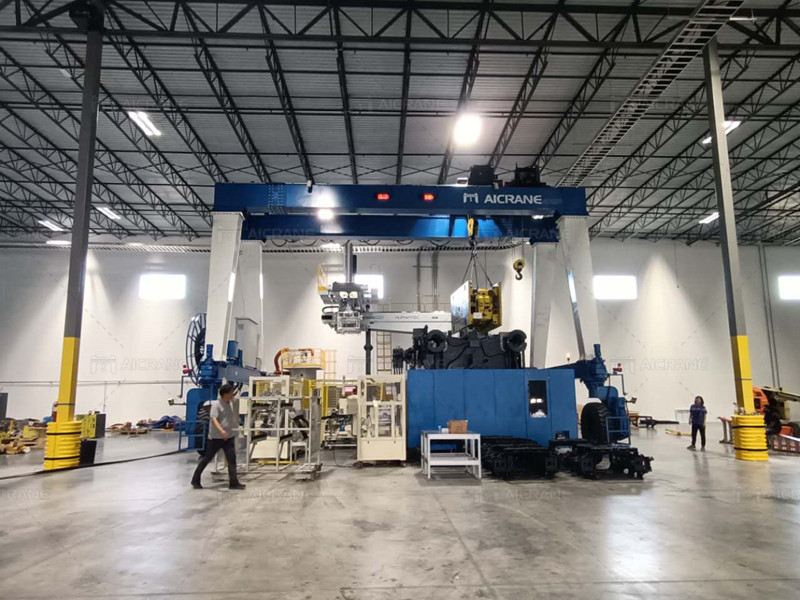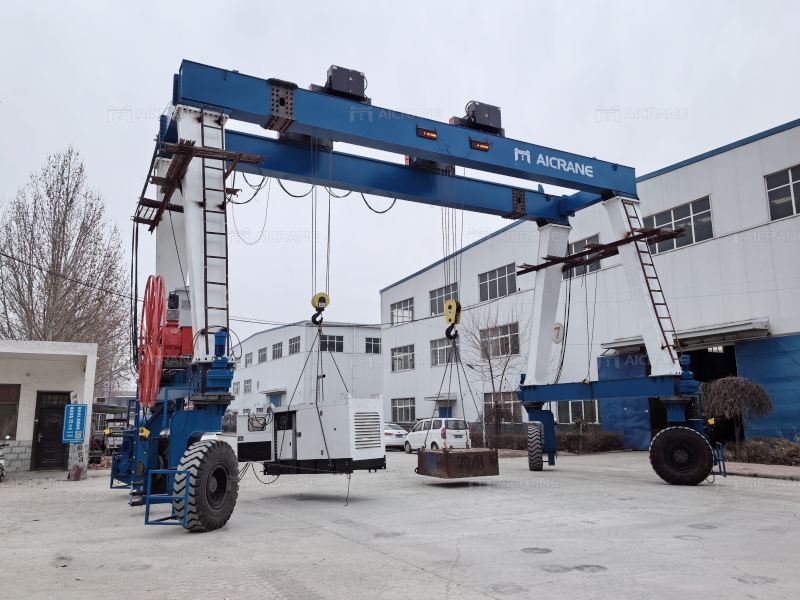Rubber-tyre gantry cranes (RTG cranes) are essential equipment in container terminals and other heavy-duty industrial applications where large loads need to be moved efficiently. These cranes are mobile and versatile, allowing them to operate in tight spaces without the need for permanent rail infrastructure, making them especially useful in dynamic environments like ports and storage yards. As demand for faster and more efficient logistics increases, so does the need to enhance the capacity of rubber-tyre gantry cranes. Increasing the capacity of RTG cranes involves optimizing their load-bearing abilities, improving operational efficiency, and implementing advanced technological innovations.
In this article, we will explore several strategies to increase the rubber-tyre gantry cranes capacity, including mechanical upgrades, advanced control systems, and operator training.

Understanding Rubber-Tyre Gantry Cranes Capacity
The capacity of a rubber-tyre gantry crane refers to the maximum load it can handle, typically measured in tons. The capacity is influenced by various factors, such as the strength of the crane’s structure, the efficiency of its hydraulic or electric lifting systems, and the crane’s overall design and build quality.
The standard capacity of an RTG crane can range from 20 tons to 65 tons, depending on the application. However, to meet growing demands, many industries are now looking for ways to push these boundaries and increase the capacity of their RTG cranes. Increasing capacity not only helps in handling heavier loads but also enables faster operations, reduced downtime, and overall cost efficiency.
Mechanical Upgrades to Increase Capacity
One of the primary ways to increase the rubber-tyre gantry cranes capacity is through mechanical upgrades and reinforcements. This includes strengthening the key components of the crane to handle more weight while maintaining safety and stability.
Reinforced Structure: The crane’s steel structure, including the gantry beams and legs, must be reinforced to bear heavier loads. This can involve using stronger, more durable materials in the crane’s construction or retrofitting existing cranes with additional structural support. Reinforcing the mainframe ensures that the crane can handle the increased stress of lifting heavier containers or materials without compromising its integrity.
Upgrading the Hoisting System: The hoisting system, which includes the hoist motors, cables, and pulleys, plays a crucial role in determining the crane’s lifting capacity. Upgrading to more powerful electric or hydraulic hoists and using higher-strength cables can significantly increase the crane’s load-handling capabilities. Additionally, investing in a dual-hoist system can distribute the load more evenly, allowing the crane to lift heavier loads without overstressing the hoist mechanism.
High-Capacity Spreaders: The spreader is the part of the crane that attaches to the container or load. Upgrading to a high-capacity spreader designed for heavier containers can also boost the crane’s lifting capacity. Some spreaders are designed to handle multiple containers simultaneously, further increasing operational efficiency.
Advanced Control Systems
Control systems are an essential part of optimizing the rubber-tyre gantry cranes capacity. Modern RTG cranes are equipped with automated and semi-automated control systems that can enhance precision, reduce operator error, and maximize efficiency during lifting operations.
Load-Sensing Technology: One way to safely increase the capacity of an RTG crane is by integrating load-sensing technology. These systems monitor the weight and balance of the load in real-time, ensuring that the crane operates within safe parameters. If an overload condition is detected, the system can either adjust the crane’s performance or shut down operations to prevent damage or accidents.
Anti-Sway Control: Handling heavier loads requires more precision to ensure the stability of both the crane and the load being lifted. Anti-sway technology uses sensors and automated controls to minimize the sway of the load as it is moved. This not only ensures safer operation but also allows for faster cycle times, as operators don’t need to manually wait for the load to stabilize. By minimizing sway, cranes can handle larger loads more efficiently and with greater control.
Automation and Remote Operation: Automation can help increase the rubber-tyre gantry cranes capacity by reducing the need for manual intervention and increasing operational speed. Remote operation, in particular, allows for more precise control and faster lifting operations, as operators can focus solely on positioning the load without the need to physically be in the crane. Some advanced RTG cranes even feature fully automated lifting sequences, allowing for faster turnover times and reduced operator fatigue.

Tire and Mobility Enhancements
The mobility of an RTG crane is one of its most valuable features, allowing it to move across a container yard without being restricted by fixed rails. To handle heavier loads, the tires and drive systems of the crane need to be enhanced.
High-Capacity Tires: The weight of the crane and the load it carries is distributed across its tires. Upgrading to high-capacity, heavy-duty rubber tires can support the increased weight and maintain the crane’s mobility. Additionally, proper tire maintenance, including regular inspections and pressure checks, ensures that the tires are functioning optimally under heavier loads.
Upgraded Drive System: The drive motors and steering mechanisms of the RTG crane also play a role in supporting increased capacity. Upgrading to more powerful motors can ensure smooth movement, even when the crane is handling its maximum load. Some RTG cranes also feature hybrid drive systems, which combine diesel and electric power to improve efficiency and allow for better performance under heavier loads.
Operator Training and Safety
Increasing the rubber-tyre gantry cranes capacity also means that operators need to be well-trained to handle the crane’s new capabilities safely. Skilled operators are essential for maximizing the potential of the crane while minimizing the risks of accidents or equipment damage.
Specialized Training: Operators must be trained to handle the crane’s increased capacity, including how to manage heavier loads, operate new control systems, and respond to potential overload situations. Training programs should include both classroom instruction and hands-on practice to ensure that operators are fully prepared to operate the crane at its maximum capacity.
Safety Protocols: As the load capacity increases, so do the safety risks. Establishing strict safety protocols and ensuring that all operators and maintenance staff are familiar with these protocols is essential. This includes regular safety inspections, adherence to load limits, and the use of personal protective equipment (PPE) when working around the crane.
Regular Maintenance and Upkeep
To ensure that the rubber-tyre gantry crane operates at its increased capacity for the long term, regular maintenance is critical. Over time, the wear and tear on the crane’s components can affect its performance, especially under the added stress of heavier loads.
Routine Inspections: Regular inspections of the crane’s structural components, hoisting system, tires, and drive motors ensure that the crane remains in good working condition. Any signs of wear or damage should be addressed immediately to prevent accidents or equipment failure.
Scheduled Maintenance: In addition to routine inspections, scheduled maintenance should be performed to replace worn-out parts, lubricate moving components, and ensure that the crane’s control systems are functioning correctly. Following the manufacturer’s maintenance guidelines (like Aicrane) will help extend the life of the crane and maintain its increased capacity.
Increasing the rubber-tyre gantry cranes capacity requires a combination of mechanical upgrades, advanced technology, skilled operators, and regular maintenance. By reinforcing the crane’s structure, upgrading its hoisting systems, and implementing modern control technologies, operators can safely and efficiently handle heavier loads. As demand for higher throughput continues to grow in industries like port operations and logistics, optimizing the capacity of RTG cranes will be essential for maintaining competitiveness and meeting the demands of modern commerce.
0